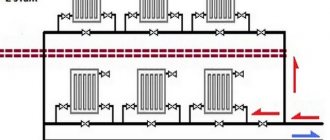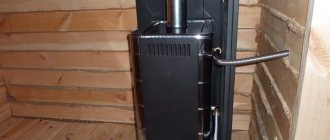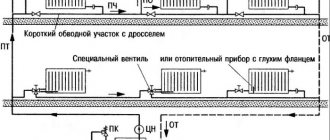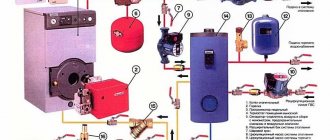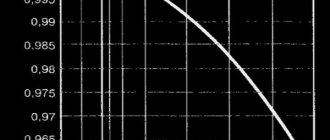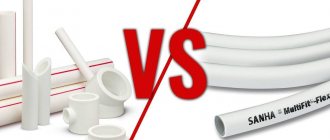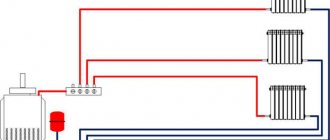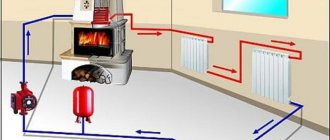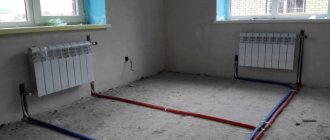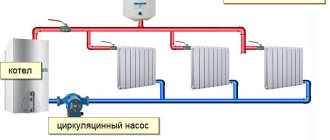Features of the operation of the forced heating system
The heating circuit, in which fuel circulates naturally, is as simple as possible. In such a chain, the coolant is heated in the boiler and, in accordance with the laws of thermodynamics, rushes up the riser. Having reached the radiators, the carrier gives up part of the thermal energy, its temperature decreases. Under the pressure of newly arriving doses of heat, the cooled fuel is lowered back into the boiler to repeat the cycle.
Such an elementary scheme has significant disadvantages, especially in combination with the single-pipe type of wiring:
- Heat is distributed unevenly: in rooms located next to the heat source (boiler), the temperature is higher than in those located at a greater distance from it.
- A system with natural circulation consumes a significant amount of heating material, which is not in favor of its rationality. These problems can be partially neutralized by installing a two-pipe distribution system.
The efficiency of a heating circuit with forced circulation is due to the inclusion of a pump in it. Its function is to impart greater speed to the movement of fuel along the heating main. The value of this indicator is directly dependent on the temperature of the heated premises.
The presence of a circulation pump in the heating system gives it undeniable advantages:
- efficiency. Associated with both the rational use of heat resources and reasonable financial costs for the purchase of small-diameter pipes;
- ergonomics. The uncluttered design allows you to hide its elements in the walls, under the floor, etc.;
- the ability to operate in heating projects of any complexity with various combinations of heating equipment. The heating circuit may contain radiators, thermal curtains, and heated floors. The main concern when designing a forced circulation heating system is the uninterrupted supply of electricity, since it is electricity that is used to drive the pump. Therefore, it is a good idea to take care of a backup power supply.
What is forced circulation used for?
Circulation pump
It is not so easy to achieve natural circulation in the heating system, since the coolant will move in pipes and radiators due to heating and cooling. In order for the system to work reliably, they try to ensure that the forward and return pipes are located at a certain angle. This system is perfect for small buildings, since it can easily withstand the required angle and a slight difference in height.
If the house has a fairly large area or has two or more floors, then it will not be possible to create a system with natural circulation, since air jams will regularly form in it. Because of this constant movement, it will not be possible to achieve, in addition, the coolant in the boiler can seriously overheat, which, in turn, threatens with quite serious consequences, for example, both the heating device itself and other elements included in this unit may fail. system.
As mentioned above, forced circulation is provided largely by a special pump. It should be installed on the return pipe before it enters the boiler itself. Thanks to this device, the required pressure will be created in the heating system, and water will also circulate at the required speed. The heated water will be supplied to the radiators and pipes in a timely manner, and the cooled water will be supplied to the boiler in order to reach the required temperature.
A heating system equipped with forced circulation has a number of positive characteristics:
- It is capable of functioning reliably in buildings with any area and any number of floors;
- Heating schemes involve the use of pipes of smaller diameter compared to natural circulation; accordingly, installing such a system will require less financial resources;
- If desired, the pipes can be buried in the floor, hiding them from view. In addition, they are installed without a slope;
- Forced circulation provides the possibility of installing water-based underfloor heating;
- The temperature regime of heating with forced circulation does not provide for excessively large temperature jumps, due to which fittings, radiators and pipes will last much longer;
- Another advantage of such a heating system is the ability to change the degree of heating of each room in the house.
It is worth noting a number of negative points. In particular, the pump itself will have to be connected to the electrical network, as a result of which the heating of the house becomes completely energy-dependent, and in addition, when used directly, it produces a certain noise. However, these disadvantages can be minimized if necessary. First of all, they pay attention to heating schemes even at the stages of their development. It is best to allocate a separate room for the boiler room, located in the back of the house, directly next to the boiler and install a circulation pump. A backup source of electric current such as a generator or battery can be placed nearby.
Forced schemes
Conventionally, all forced schemes can be divided into one-pipe and two-pipe. The most popular today are two-pipe ones. But let's look at the differences
Single-pipe connection diagram
It involves the operation of one pipe for supplying coolant from the boiler and for its return outflow. This option does not require large pipe footage, the number of shut-off valves, fittings and other elements, therefore, installation work is reduced to a minimum. Minus: sequential heating of heating devices gradually reduces the temperature of the supplied fuel in the equipment chain. The heating system can operate in a natural or forced way.
Scheme of a single-pipe heating system for a two-story house
This is an outdated model, which is actually not used in any way for individual heating of housing; it has only one supply line, into which radiators and batteries are gradually connected.
The only advantage of this scheme is the small footage of the pipelines. single -pipe system contains a number of significant disadvantages:
- Uneven separation of coolant. The further the heat exchanger is from the boiler, the lower the heating level of the hot water entering it;
- To carry out repair work, you should stop the heating boiler and wait until the coolant temperature drops to the standard value.
The pump power for single-pipe heating will be less than for two-pipe heating. This is due to the smallest size of the coolant in the system. In addition, less space is required for laying single-pipe pipelines - they can be inserted in front of the floor, baseboards.
For a single-pipe heating system, it is imperative to calculate the installation of a bypass for any radiator. This makes it possible to turn off the device without completely stopping the heat supply to the home.
Two-pipe connection diagram
In this heating model, two pipes work: the first supplies fuel to the heater, the second removes the cooled medium to the boiler.
This is the main difference from the first option, with the ensuing consequences: an increase in the metal consumption of the structure due to larger pipe measurements, shut-off and connecting elements in the circuit. Installation is more complicated. A positive point, as a reward for the financial and labor costs incurred: each heater in the system is supplied with coolant of the same temperature. Depending on the direction of flow of hot and cooled fuel, there are:
- a parallel connection diagram, where the coolant supply and its removal move in the same direction, allowing all devices in the chain to heat up at the same speed;
- dead-end, which involves faster heating of devices located closer to the boiler.
Beam wiring
A very similar modification to a two-pipe forced circulation heating circuit. The difference is the point of distribution of hot fuel and the collection of cooled fuel, which is not the main riser, but distribution manifolds. Each heating device has a separate coolant supply and drainage line. Of course, such a scheme assumes a balanced heat distribution in temperature and pressure. The overhead of such a heating arrangement is obvious: significant costs for materials, high cost and labor-intensive installation work. In addition, it is very difficult to make adjustments to the circuit with distribution nodes (for example, adding heating equipment).
Closed system diagrams
The following types of wiring are used for heating country and country houses:
- Single-pipe. All radiators are connected to a single main line running along the perimeter of the room or building. Since the hot and cooled coolant move through the same pipe, each subsequent battery receives less heat than the previous one.
- Two-pipe. Here, heated water enters the heating devices through one line and leaves through the second. The most common and reliable option for any residential buildings.
- Passing (Tichelman loop). Same as two-pipe, only the cooled water flows in the same direction as the hot water, rather than returning in the opposite direction (shown in the diagram below).
- Collector or beam. Each battery receives coolant through a separate pipeline connected to a common comb.
Single-pipe horizontal distribution (Leningrad)
Reference. Single-pipe systems can be horizontal (the so-called Leningradka) and vertical. The latter, where water is distributed to heating devices from risers, are often used in two-story houses.
The single-pipe horizontal scheme justifies itself in one-story houses with a small area (up to 100 m²), where heating is provided by 4-5 radiators. You should not connect more to one branch, the last batteries will be too cold. The option with vertical risers is suitable for a building of 2-3 floors, but during the implementation process it will be necessary to go through ceiling pipes in almost every room.
Installation of heated floors
A truly complex scheme with forced circulation of heating, which is also expensive, but also the most comfortable. In small rooms, simple combinations of pipe laying are used with one inlet for the heated coolant and an outlet for the cooled one. Larger areas will require more complex designs using distribution node connections. Often, installing a heated floor involves installing a separate circulation pump in sections of the system.
Open and closed heating circuit using a pump
The coolant moving in the pipes gains volume during the heating process. The resulting excessive amount flows into a specially equipped container. An open heating system provides for the installation of a maximum height expansion tank in the current, in which the atmospheric environment and the coolant are directly connected.
Conceptual diagram of the operation of the circuit: an increase in temperature provokes an increase in the coolant in volume and, as a consequence, its level in the expansion tank. A certain amount of air from the tank is removed through the pipe. As the temperature drops, the fuel level in the tank decreases, and its place is taken by external air coming from the nozzle.
A closed heating system with forced circulation uses a pressurized expansion tank. It is presented in the form of a high-strength metal container, consisting of a pair of rolled parts. The tank contains a rubber heat-resistant membrane and contains a small amount of gas (nitrogen pumped in by the manufacturer or air accumulated in the system). The membrane divides the tank into two halves: one receives excess coolant that appears during heating, the other is intended for air or nitrogen that does not interact with the fuel. The system operates as follows: the coolant is supplied to the expansion tank when heated, and enters the membrane. During the cooling process, the gas on the other side of the membrane pushes the coolant back into the system.
Positive aspects and disadvantages
The closed version of the water system has gained popularity due to its many advantages:
- there is no contact with the atmosphere - there is no loss of coolant due to evaporation;
- antifreeze can be used to fill the network in a periodically heated building;
- here there is no need for large-diameter pipes laid with a significant slope, as is done when installing mains with natural circulation of water;
- there is no heat loss through the sealed expansion tank, so the scheme is considered more economical;
- water under pressure warms up much faster and boils at a higher temperature, which reduces the risk of vapor lock formation in an emergency;
- a closed type system lends itself well to regulation both in individual areas and as a whole.
Note. Tightness provides another important advantage - the coolant is not saturated with atmospheric air through the open tank. Air bubbles can enter the pipelines only through make-up from the water supply or through cracks in the tank membrane.
Laying pipelines in the floor and inside walls
Small pipeline diameters and forced circulation are the most important arguments in favor of modern closed heating networks. All wiring can be hidden in walls or floors, and pipes can be laid with a minimal slope. It serves only to drain water during repairs or flushing of radiators and lines.
Now about the fly in the ointment. The fact is that the closed heating system of a private house is unable to function autonomously, since it depends on electricity powering the pump. Therefore, if there are frequent power outages, it is recommended to get an uninterruptible power supply unit or an electric generator so as not to be left without heat.
Reference. On the Internet you can find alternative options - closed systems modeled after gravity (gravity-flow) ones. That is, large pipes with significant slopes. But then half of the above advantages are lost, and the cost of installation increases.
The second negative point is the difficulty of removing air pockets during the process of pouring water, pressure testing and starting the heating. But this minus will not become a problem if air is removed according to generally accepted technology.
Selecting a circulation pump
A high-quality pump for a forced circulation heating system must meet the following criteria:
- energy saving;
- simplicity and reliability in operation.
Power characteristics are determined by the dimensions of the living space that needs to be heated. For example, to heat an area of 250 sq.m, a circulation pump with a capacity of 3.5 cubic meters per hour and a pressure of 0.4 atm is required. In addition, the choice of equipment is influenced by calculations from the heating system design. These include:
- material of pipes intended for installation and their diameter;
- total footage of the scheme;
- number of heating devices;
- type of coolant.
Selecting a pump yourself can cause a number of difficulties, so it is best to get advice from a competent specialist on this issue.
The need to maintain pipe slope
When installing a heating system with forced circulation of coolant, compliance with the requirements for pipe slope is not necessary. Heating mains are installed straight or with a slight slope in relation to the drain. This will make it easier to drain the coolant before carrying out repair work or if a situation arises when the system faces a long downtime.
Elements of a closed heating circuit
The main elements of a forced circulation heating system are:
- boiler (solid fuel, gas, etc.);
- membrane-type sealed expansion tank;
- circulation pump selected according to power;
- heating radiators (batteries);
- pipes for the construction of risers, lintels and connections;
- adapters for connecting pipes (fittings);
- ball and plug valves;
- check valves;
- air vents;
- filters necessary to maintain the operation of the heating boiler and pumps;
- fastening devices (clamps, etc.).
Diagram of a closed-type heating system in a private house with installation of a circulation pump and a sealed membrane tank on the return line
Pipe diameter in forced system
A heating system that includes a circulation pump does not place any special demands on the pipeline. For such a scheme, it does not matter what size and composition of the pipes will transfer heat. Thus, inexpensive models with small diameters can be used. This will save a decent amount when organizing heating. We should not forget that the parameters of the pipes are taken into account when purchasing a circulation pump.
It is important to understand that with smaller pipeline diameters in a forced circulation system, resistance also increases.
Types of heating schemes
A properly equipped heating system ensures the comfort of every home. In particular, the heating model of a two-story house requires careful planning, because it requires raising water in the pipes to a height.
Almost all heating systems use only forced circulation of coolant, which provides significant advantages:
- The use of circulation pumps can help heat every area, regardless of the number of floors in a building.
- The diameter of the pipes can be significantly smaller, since the pump makes it possible to pump the coolant at a higher speed.
- The use of circulating pumps makes it possible to reduce the temperature in heating modes at the same heat transfer parameters of radiators, and this, in turn, makes it possible to use the most affordable polymer and metal-plastic pipes.
- Possibility of both general and zonal regulation.
Flaws:
- Dependence on electricity, which is easily solved by the presence of uninterruptible power supplies or generators.
- The highest sound of heating operation, however, if calculated correctly, it is not audible in heated rooms.
The circulation pump, as a rule, is inserted into the heating system in the opposite line in front of the boiler, since this area has the lowest coolant temperature.
The basic principle of heating operation is to install pumps to increase the flow rate of the coolant. The position of their installation directly depends on the selected piping layout.
In addition, the heating system of private housing with forced circulation must contain safety categories. This is necessary to quickly stabilize the pressure in the pipes due to possible overheating of the coolant. Any type of heating contains a number of features that directly affect the selection in a particular case. However, the system , in addition to the pump, must include the following components:
- Safety group: air vent and bleed valve. Placed immediately after the boiler;
- Expansion tank. It is best to select a membrane-type system with the prospect of changing a flexible valve;
- The piping of any radiator must have a balancing valve and a Mayevsky tap. It is preferable to install a thermostat;
- Shut-off valves. It is needed to partially or completely shut off the coolant in a certain place in the system.
Each of the above parts must have operating properties corresponding to the characteristics of a particular heating system. Otherwise, they will not perform the functions assigned to them.
The selection of installed parts of the system is carried out according to a pre-designed residential heating scheme with forced circulation. The calculation must be extremely accurate - using special programs or done by specialists.
The main disadvantage of forced heating
Since heating a house with forced circulation works only with a circulation pump. Therefore, such a pump needs a stable and high-quality supply of electricity.
This is the only and biggest disadvantage of heating a house with forced circulation. For example, your electricity was cut off. There is no heating. Electrical network failure - no heating. The voltage in the network has dropped - the pump does not produce rated power - again there is no heating.
How to improve a forced circulation system?
It is, of course, advisable to properly insulate the pipes of heating systems in order to minimize the loss of precious heat. Then it will be economical. The main thing when choosing a forced circulation system for your home is not to make a mistake when calculating it.
It is necessary to pay close attention to the number of heating appliances, the number of heating circuits, selection of the optimal pipe diameter and pump power.
It is with the violation of these laws that the most problems arise. Either they incorrectly calculated the number of devices, or they narrowed the pipelines and there is not enough heat for the radiators, or they installed a weak pump that wears out, and so on.
